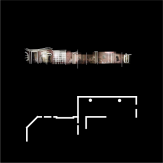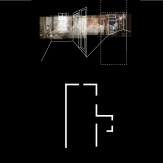2020 Benjamin Menschel Fellowship Exhibition
Thu, Feb 18, 6pm - Sun, Feb 28, 2021 12pm
Note: Although the Cooper Union buildings remain closed to the public, the Menschel exhibition may be viewed by faculty, staff and students approved for being on campus.
The Menschel Fellowship application cycle—proposals, shortlists, interviews and awards— typically runs from February to early April each year, after which the Fellows pursue their research projects. In 2020, this timeline coincided almost exactly with the rapid outbreak of the Covid-19 pandemic. New York was especially hard hit and travel suddenly became impossible. The applicants had proposed ideas that involved research travel, but were forced to adapt and reimagine their questions for this unexpected hurdle. The projects that are part of this year’s Benjamin Menschel Fellowship Exhibition push the boundaries of research, analysis and intervention. The exhibition is a testament to the resilience of our community, and to the idea that good research offers us hope during challenging times. —Ninad Pandit, Director Benjamin Menschel Fellowship
This year's fellowship projects include:
- Collective Memory -- Andzelika Berestko A’22
- A Domestic Psychogeography of Social Housing in the Soviet Union -- Zhenia Dementyeva AR’21
- Public’s Space: Transforming Public Space Through Educational Occupancy -- Zalmai Levrat AR’21 & Maksymilian Mamak AR’21
- Tracing Community in Ger Settlements in Ulaanbaatar -- Min Jeong Park AR’21
- Architectures of Consciousness -- Ornella Polo A’21
- In the Land of Milk and Honey: Amirim -- Netanel Saso A’21
Located in the 41 Cooper Gallery, located in 41 Cooper Square, on Third Avenue between 6th and 7th Streets.
Projects
-
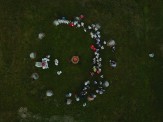
Collective Memory -- Menschel Fellowship Exhibition 2020
-
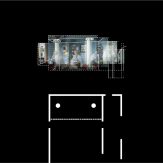
A Domestic Psychogeography of Social Housing in the Soviet Union -- Menschel Fellowship Exhibition 2020
-

Public's Space -- Menschel Fellowship Exhibition 2020
-
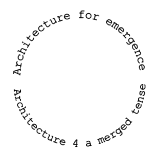
Architectures of Consciousness -- Menschel Fellowship Exhibition 2020
-

In the Land of Milk and Honey: Amirim -- Menschel Fellowship Exhibition 2020
-

Tracing Community in Ger settlement in Ulaanbaatar -- Menschel Fellowship Exhibition 2020
Back
Collective Memory -- Menschel Fellowship Exhibition 2020
-

Native Faith’s Stone Circle during celebration of Summer Solstice, June 20th, 2020
-

Native Faith’s Stone Circle during celebration of Summer Solstice, June 20th, 2020
-
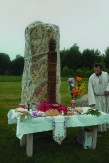
Światowid’s altar, the Supreme Diety in the Native Faith pantheon
-

Women honor the fire by dancing with crowns of field flowers on their heads
-
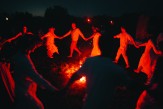
The Kupała’s Night Celebration, Poland
ANDZELIKA BERESTKO A’22
All is darkness, all is quiet—
Haste we to the sacred rite
Darkness and secrets everywhere;
We’re guided by both faith and song.
Onward, with us, you who despair;
All who remember, all who long.
-- Mickiewicz, Adam. Forefather’s Eve. Part II, 1823
Honoring Summer Solstice has been a part of Native Faith’s religious culture since its beginnings. In the year of 2020, after the dusk of June 20th, Polish practitioners celebrate the shortest night of the year. In the silence between the emergence of the moon and descending of the sun behind the horizon’s bed, they stand among grasses and weeds. Women wear long dresses made out of linen or cotton, their feet gliding in smooth motions as they dance. Their heads are decorated with flower crowns that are knotted into their long flowing or braided hair. All the details of dress are meant to bring prosperity in love life in the upcoming year, but especially in the next Moon Cycle.
Since Kupała’s Night is one of the four main celebrations in the Native Faith, it is often coupled with other rites of passage, such as marriage, the haircut ceremony, or blessings to the dead. The relationship with the land is at the core of this religious culture. It is a spirituality found in the smallest particles of the material world, where each organic atom can be connected with a larger energy that links all elements together, binding people to the place of their ancestry and placing the utmost importance on blood lineage.
The practice of Native Faith has been discouraged since the official baptism of Poland in 966 CE, considered to be the birth of the country. Yet in the 13th century there was still an interesting mesh of beliefs present, where the population worships Światowid (The World-Seer), the deity that rules over the four directions of the world, and simultaneously begs the Virgin Mary for protection over their children. The prayers like “Bogurodzica” (“Mother of God”) are sung constantly while the worship of nature’s forces is forbidden by the Catholic Church. The earth-centered culture is kept strong in less populated areas of the country, where folktales are regularly repeated and small shrines grace the sides of the roads. One can see wooden structures that aid the pilgrims by providing them a place to rest on the ground and behold the image of the deity—usually a Christian Saint, occasionally a Native Faith lordship.
Years later, when Poland had a Communist political system, the Catholic Church played a crucial role in guiding people in their daily lives. Schools were linked with churches; each was assigned to a specific parish. This practice continues today as well, where, during important historical celebrations, students and teachers march before the altar of Christ and pray for his protection over their community. Church-going was a social obligation during those times. Concurrently, since priests had authority, they used their platform to preach the message of unity and collective organization. Population of workers were inspired by Pope John Paul II, the head of the Catholic Church at that time, to come together and protest against Communism. Priest Jerzy Aleksander Popiełuszko was another religious leader who preached to mine workers in Gdynia where the strikes commenced. Faith was thus tightly linked with protest against the government.
Years after the fall of Communism in Poland in 1989, the Native Faith groups re-established their religious organization on the basis of ethno-religious minority in the country. There was an overarching nostalgia for the past and a search for what constituted Slavic-ness. Folk traditions re-emerged as a popular interest, yet they were majorly focused on the aesthetics of the dress and the sound of the archaic language. Nonetheless, the Native Faith gained more followers, and once again existed on Polish grounds.
Collective Memory is an attempt to understand how the Native Faith of Poland functions within the larger fabric of the society and to explore the group’s motives. It becomes clear that entrance into the organization is a statement of protest against the Catholic church, since one chooses the Światowid and ancestors as their religious authorities. Also, the group is founded on the basis of exclusion, as only persons who carry a Slavic-sounding last name, and who speak Polish fluently are admitted into the inner circle of practitioners.
The exhibited pieces serve as excerpts of larger happenings. They are short experiences meant to stir a reaction in the viewer to the Native Faith rituals and the archaic language. These glimpses also relate to the literary works sampled in Polish educational system that creates a negative impression of pre-Christian beliefs. The videos are composed from archival footage, documentation gathered during the 2020 Summer Solstice, and personal artifacts that become universal when understood in the larger context of shared generational memory.
In addition to audiovisual works, Collective Memory is also embodied in research-based scholarly writing, which aims to give a voice to a nuanced relationship between faith, protest, nationalism, nostalgia for the past, and a lack of belonging within a system. Analyzing the revival of Native Faith brings a cohort of complexities, which demand proper space and attention in order to be understood. The project thus re-establishes the process of unveiling these intricacies as ongoing, with a lifespan that will continue long after the exhibition is disassembled.
Photos by Timur Turan
A Domestic Psychogeography of Social Housing in the Soviet Union -- Menschel Fellowship Exhibition 2020
ZHENIA DEMENTYEVA AR’21
A Domestic Psychogeography of Social Housing in the Soviet Union uses Soviet films as a way to examine the psychological perception of space, and to explore how that perception might be physicalized in an object.
In spite of the physical nature of space, our understanding of it is largely assembled from fragments and glimpses in our memory. Because we can exist in but one room at a time, our conception of space is almost entirely psychological. This speculation about the nature of psychogeography was developed by the Situationists, an alliance of French avant-garde artists, writers, and poets, who famously thought of the city as a fantastic landscape—one that exists in many spatial-temporal dimensions. Drawing inspiration from the work of Karl Marx and from socialist concepts, Guy Debord, a key member of the Situationist movement, traces the development of a modern society in which authentic social life has been replaced with its representation: “In societies where modern conditions of production prevail, life is presented as an immense accumulation of spectacle. Everything that was directly lived has receded into a representation.”
While the Situationists deeply researched modern society’s spectacle in the form of the city, they somehow missed an investigation of the spaces in which society finds refuge: domestic space. Because the Situationists were committed to exploring the construction of a collective imaginary from individual experiences, it is relevant to consider their practices today, at a time when physical isolation has forced the home to become a world of its own. Moreover, through its glorification by Soviet cinema, the individual home in the USSR became a psychogeography of the collective state of social domestic existence.
Over the last hundred years, Russia has seen dramatic shifts in political ideologies that few other countries have in their entire histories. Joseph Stalin, Nikita Khrushchev, and Leonid Brezhnev are three leaders from the USSR that have had a significant impact on the construction of modern Moscow. Because Moscow was the capital of the Soviet Union, the city was meant to be a physical symbol of Communist power over capitalism. The green, spacious, and robust urban design and architectural vision of Moscow during the twentieth century was designed to contrast the congested, cramped cities of the capitalist west. In a way, design of the city was the engine for the creation of the ideal Communist society.
The scale of domestic space was also central in the development of the ideal Communist society. From the aggregation of units and apartment blocks down to the way each room in an apartment was meant to be used, the Communist design of housing was deemed essential to the Communist party. Housing fundamentally defines human habits. It fosters relationships between people, develops cultural institutions, and determines commercial functions. Indeed, a city would not be a city without its inhabitants—and thus, a city could not exist without housing.
The manifestation of housing within the city is binary. On the one hand, the apartment building’s outward appearance bears a certain power on a collective image of the urban fabric. In the case of the Soviet Union, this means that the apartment block is typically a rectilinear concrete box: long, narrow, and ranging between 5 and 15 stories in height. These aggregate in the residential districts of the city, separated by trees, playgrounds, and car-filled streets.
The second expression of housing in the urban context is the relationship it has with the city-dweller. This phenomenon is significantly more subtle and is subjective, dependent on each individual apartment and its inhabitant. Inevitably, the living unit informs the behavior of its inhabitant, and the inhabitant then carries that relationship out into his or her life as a participant in the collective urban society. The way that this relationship between the individual and the domestic space is reflected in collective society is intangible, but it can be captured in certain visual media—such as cinema. Cinema can capture the workings of domestic life through its simultaneously visual and narrative documentation, creating a psychogeography that collectively constructs a representation of those impressions and relationships.
The dynamic, constantly evolving landscape of construction in Moscow in the twentieth century has left an unmistakable impression on Russian cultural memory. This is most clearly articulated in the movies by Mosfilm, a public cinema studio that was funded by the Communist Party. Movies produced by Mosfilm, such as Irony of Fate (1976), The Pokrovsky Gate (1982), Moscow Does Not Believe in Tears (1980), and Walking in the Streets of Moscow (1964) each intertwine architecture, plot, and human interaction in a way that brings out the social implications of new Soviet construction for the Russian population.
One of the most compelling ways in which social housing is documented is in Soviet films. An analysis of Soviet films will provide a social frame with which to contextualize the drafted drawings of Soviet housing. I selected these films because architecture plays a central role in the plot of each. For example, The Pokrovsky Gate follows a group of people living in a communal apartment building and preparing to move into a newly erected public housing block—khruschevka. The protagonists are concerned about this move, for it means that they will be living farther from the center of town and in a generally unfamiliar setting. In Moscow Does Not Believe in Tears, a move to a newly built khruschevka becomes a symbol of success for “the modern woman.” Because housing was such a central element in Soviet leaders’ political program, movies produced by the publicly funded Kinostudiya Mosfilm highlight the significant impact that construction had on Muscovites.
As I study these Soviet films, I would like to begin creating a film that articulates the relationship between the inhabitant and the building which, by extension, draws a connection back to the relationship between the building and the political ideology that created it. The drawings that are a part of this show represent a psychogeography of the inside and outside spaces of social housing. Guy Debord famously defined psychogeography and the concept of the derive as “precise laws and specific effects of the geographical environment, consciously organized or not, on the emotions and behavior of individuals.” I find that the Situationist representations of psychogeography is evocative of the movements of film cameras and the drifting narratives that are created through camera panning. I hope that by creating composite drawings, I will be able to draw out the unseen ways that these Communist-era apartments influenced Muscovites' habits and psyches.
There are a multitude of precedents that inform this research project—each of them contributing to the exploration of interior psychogeographies of social housing in their own way. These precedents range from performance art all the way to home furnishing.
Public's Space -- Menschel Fellowship Exhibition 2020
ZALMAI LEVRAT AR’21 | MAKSYMILIAN MAMAK AR’21
In the midst of a global pandemic, in the wake of the murder of George Floyd, and in anticipation of the NYPD’s budget reassessment, a small group of Black-led protestors empowered themselves to occupy New York’s City Hall (June 23rd - July 22nd, 2020). This occupation was an embodied negotiation regarding the city’s budget, specifically a demand to defund the police — by at least a billion dollars — and re-allocate that money toward social services that address the root of the problem of inequality. #Occupycityhall, which eventually transitioned into Abolition Park, were radical manifestations of contemporary civic praxis; fighting inequality rooted in a pluralistic expression of information, education, and action. Through occupational domesticity and intimate mutual-aid-centered programs, we sustained the encampment and transformed it into a civic space of educational agency right in the heart of New York City’s open and official Civic Center.
This research initiative is an embodied investigation into contemporary civic praxis. Through our mutual participation, documentation, and collaboration with the community that emerged from these events, we developed a reimagined understanding of what 21st century civic agency is and the frameworks it operates within. The culmination of this work lies in the creation of our virtual platform, rosefromapark.com, which creates a place of educational civic praxis that people can contribute to, learn from, and join forces with. Through the exhibition we are exploring alternative material and formal possibilities for the communal-domestic scale of educational praxis.
Our initial proposal for the Menschel Fellowship, written in mid-May 2020, was to research the civic spaces of a world capital, specifically Brussels’ civic spaces, which operated at three scales: at the scale of a city, at the scale of a country, and the scale of a continent (nearly all of the European Union civic buildings belong there). Yet our optimism about the summer ended as Covid-19 only grew in reach, having a particularly devastating effect on Brussels. At the same time, Black Lives Matter protests began erupting all over the globe, centering civic engagement around this topic. As we reached the next stage of the proposal process, we quickly realigned our focus regarding occupation of civic spaces to the relationship between Washington D.C. and Belgium, and the parallels they shared at the moment. By the time we were approved for the fellowship, and received the funds to pursue our research, #occupycityhall had just started. We immediately bought a 360 camera and went to support the occupation instead.
Due to the immersive, constantly changing, spatial experience of the occupation, our initial goal was to capture the totality of the encampment. The 360 camera allowed us to capture the civic landscape without the political implications of a “frame.” With consistent documentation of different locations, programs, time of day, and events, we were able to combine the photographs into a virtual tour of #occupycityhall. “All faces will be blurred” hung under our camera, establishing a promise to the occupants that the post-production treatment of the footage would provide adequate anonymity for everyone present. This post-production process consisted of posturizing the photographs to defamiliarize the people captured from machine-learning datasets, as well as highlighting the bright colors that transformed the gray public space into a colorful civic space.
#Occupycityhall was intended to only last one week, the week before the budget deadline, yet as July 1st passed, many of the protestors noted that the “reallocation” of the budget substantially changed nothing. With some of the protestors choosing to stay as a means of further protest, with a more universal call for systemic abolition, the encampment began to be called Abolition Park. It continued to operate for three more weeks, acting as a home base for protests crossing the Brooklyn bridge, hosting educational workshops and lectures, as well as establishing one of the only safe spaces for the homeless community in New York City. Although Abolition Park maintained the same size and offered the same amount of mutual aid programs as #occupycityhall, its number of occupants and resources were drastically smaller, which eventually allowed the NYPD’s pre-dawn raid on July 22nd to successfully end the encampment.
Despite the destruction of the encampment, Abolition Park did not die there. What followed was a flurry of decentralized event-based occupations across New York City as a means of continue our civic agency. The 24-hour protest, which started from a press conference held in Columbus Park regarding the NYPD pre-dawn raid, was a protest that moved through many of the major avenues of the city with pit-stops at nearly every public space and park that connected them. The establishment of the Abolition Living Room in front of Governor’s Cuomo's office was another example of an occupational event that furthered our civic agency. By establishing an intimate place for the public through the domestic scale of furniture and signs, we sought to have a conversation with the Governor regarding the homelessness problem in New York. Lastly, the Art of Abolition: Living Gallery was an event in partnership with the Black Wall Street Gallery on Canal St., which provided its gallery for a week of live-streamed creative and educational events hosted by the Abolition Park community. Throughout all these events, the complex inter-relationships of occupational domesticity, education, media, and community was revealed throughout our research and praxis.
We hope to continue our research on these forms and scales of civic praxis and intend to include a second installation of our Menschel exhibition in the end-of-year show. This second exhibition will use the language of the library found in #occupycityhall/Abolition Park, as well as our own formal discoveries from the first exhibition, and hope to occupy a place outside of The Cooper Union. By introducing a place for communal-domestic scale of educational praxis into the streets of the city, we hope to further the dialogue with its community and create greater access of the educational aspects of this research.
Architectures of Consciousness -- Menschel Fellowship Exhibition 2020
ORNELLA POLO A’21
To search for and closely observe elements that contribute to connect as communities and individuals.
“Karen” refers to a “heterogeneous lot of ethnic groups that do not share a common language, culture, religion, or material characteristics.” (Cheesman). After a history of displacement and migration, the village of the Karen Hill tribe in northern Thailand expands their culture to their relationship with and the respect for a group of elephants. Regardless of the industrial forces of elephant tourism, the community continues to work to preserve harmony through their knowledge as elephant caretakers, also known as “mahouts.”
The search for points of connection is realized through the identification of windows into individual processes that occur within our daily interactions and communication that may facilitate understanding and accessibility. Following these languages, volunteering can be an opportunity to explore and find spaces of heightened awareness of the effects of our diverse kinds of contact. Since being physically present in a volunteer program was not possible within the time-frame of the Benjamin Menschel Fellowship, the investigation focused on expanding on previous research that inspired the initial proposal for this project: through a collection of elements found in interviews with members of my community and family, artists, and historical and professional references of social and environmental identification, including the Mahouts Elephant Foundation’s interviews with Mahouts and observations on the elephant society; medical ethnical references; medical views on SARS-CoV-2 virus mechanisms as social behavior; and studies on public relations approaches.
Through drawing in the form of concrete poetry; 11 drawings explore the construction of 11 elements that correspond to the learned from studies and experiences encountered when asking the question: Can you remember moments that you feel have involved harmonious communication/cohabitation?
The next phase of the research will take place with the Karen Hill Tribe and the Mahouts Elephant Foundation LIFE volunteer program near the town of Mae Sot, in Thailand. Volunteering with them will be an opportunity to have an active involvement and deeper understanding of the local dynamics. Moreover, it will allow for further research and close observation of the processes and values of volunteer work with a community that coexists with one of the last protected forests in northern Thailand and the elephants that inhabit the forest. This investigation of interactions between humans, elephants and the environment may articulate levels of consciousness that we could perhaps expand on in our own communities.
The Mahouts Elephant Foundation collaborates to foster this mission, while conducting research to answer questions on how elephants experience their world and how we can provide for their best life possible as semi-wild animals in a large, protected forest. My project is focused through this non-profit foundation, as their concerns and labor encompass matters that are aligned with various building blocks of the research –ideas grounded in considerations of space/environment, community, spirituality, and collaboration.
What does it/can it mean to volunteer within our individual and local communities?
In the development and investigation of the collected elements, processes, and ideas through concrete poetry; the first volume of 11 drawings presented at the Benjamin Menschel Fellowship Exhibition attempts to illustrate/describe moments observed in communication, collaboration, and coexistence. They are recordings of awareness during interpersonal communication and interactions with the environments we inhabit. From these interests, this project also hopes to continue the conversation on current efforts to redefine accessibility through the acknowledgement of the diversity of forms it can take and the effects corresponding to each form; efforts to stop treating the word accessibility as a brand and instead to treat it as a concept that deserves close examination.
Works Cited
“Karen” (Cheesman, Nick, 2 September 2002, "Seeing 'Karen' in the Union of Myanmar").Asian Ethnicity. Carfax Publishing. 3 (2): 199–220.
For a full list of acknowledgements, please check the handout at the show.
In the Land of Milk and Honey: Amirim -- Menschel Fellowship Exhibition 2020
-

My grandfather and I in quarantine pictured with matching tattoos, Neve Oz, Petah Tikva
-
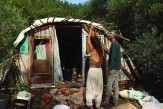
Danielle and Ofek pictured building the ecological tiny house, Amirim
-
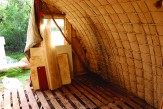
Inside of the ecological home, Amirim
-
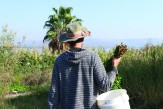
Ofek (a raw vegan born and raised in Amirim), pictured foraging for food, Galilee
-
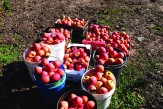
Apples gathered after a trip with gleaners around the Golan
-
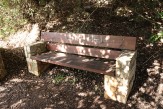
A bench with graffiti in Amirim
-
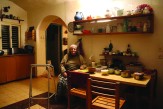
Aviva Carmeli in her home, an original founder of the village of Amirim
-
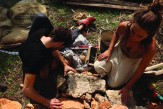
Danielle and Etan, assisting with the ecological home, Amirim
-
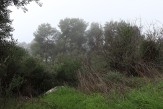
Nature photograph in Amirim
-

Danielle, Amirim resident, foraging for food, Golan
NETANEL SASO A’21
The United Nations published a report titled “Assessing the Environmental Impacts of Consumption and Production” in June of 2010. In this report, they highlighted how agricultural production accounts for an astonishing 70% of global freshwater consumption, 38% of the total land use, and 14% of the world’s greenhouse gas emissions. The report concludes that nearly two-thirds of greenhouse gas emissions from agriculture are due to livestock systems, as animal waste emits toxic gases into the air. Cows that are forced to eat low-quality grains form large amounts of gas due to indigestion, which results in the production of nearly 40% of the global methane that enters our atmosphere. Still, due to population growth, the UN Food and Agriculture Organization predicts that there will be a rise in meat consumption by 2050 of up to 76%. This raises concerns, as the rise in consumption is directly correlated to the raising of livestock, and will therefore also induce further environmental damage. It is most crucial that the UN report states that “a substantial reduction of impacts would only be possible with a substantial worldwide diet change, away from animal products” (UNEP).
The nation of Israel, born in 1948, has come a long way in its fight for animal liberation. Today, 13% of the population is vegetarian, and more than 5.2% of the population is vegan, nearly doubling from 2.6% in 2010. Even Israel’s president is vegetarian. How is it that a country so small and relatively new, is leading a vegan revolution, with more vegans per capita than any country in the world? When I was in Israel in the summer of 2019, I began to notice that almost every restaurant in Tel-Aviv was vegan and vegetarian friendly and had a sticker noting so on their windows. It was comparable to the inspection grades that must legally be displayed outside of New York City restaurants. Being born in Israel to a Jewish family that was also vegetarian helps explain why my walk around Tel-Aviv was not as shocking as it might have been to others. In the Torah, it is said that for the first 1,500 years after the creation of Adam and Eve, every human on the earth was vegan. When meat gets introduced in the text, its consumption comes with strict laws. Some of these laws include not causing unnecessary harm or pain to animals, not allowing one animal to witness the slaughter of another animal, and for each slaughter to be performed by a ritual slaughterer who is trained to kill the animal in a way designed to minimize the animal’s suffering. Though these laws were easier to follow and made more sense prior to the industrial revolution, these values are vital to Israeli and Jewish communities and are a possible reason for such a large percentage of the population being vegan and vegetarian.
In 2019, I took a gap year from college because I was diagnosed with Crohn's disease. Crohn’s is an autoimmune disease that has symptoms ranging from abdominal pain to severe weight loss. As my body was deteriorating right before my eyes, the countless doctors I visited never even made me aware of the option to change to a whole-food, plant-based diet. They were quick to diagnose expensive steroid medication, immunosuppressants, and even surgery. Luckily, I eventually found one of the best gastroenterologists in the world, right in Manhattan. He told me that he would not even give his own daughter the common medicine used for Crohn’s patients, and challenged me to see if I could drastically change my diet to reverse my disease. I instantly booked a flight to go live with my grandfather in Israel for the year. I knew that the resources I would need to make a shift in my diet would be more easily accessible in a nation that has its own animal rights advisor to the prime minister.
Through switching to and studying whole-food, plant-based nutrition in a tiny house in my grandfather’s backyard in Neve Oz, Petah Tikva, I was able to not only reverse my disease by the end of the year but found myself living a more sustainable life. I was producing almost zero-waste, as all my scraps went to the compost bin, and was growing all of my fruits and vegetables in the yard. It was during this time that I discovered a village 3 hours away in northern Israel called Amirim. This is a little-known settlement of less than a thousand people founded in 1958 for vegans and vegetarians only. Before acquiring a home, future community members have to sign an agreement stating that they are vegetarian or vegan, that they will not barbecue meat outside, and that they will not use any pesticides for any crops they decide to grow. After a few trips to the village, I knew that I wanted to make a documentary about its history and inhabitants one day.
In the Land of Milk and Honey: Amirim, is a three-part documentary film shot from 2020 to 2021 in Israel, which unpacks global issues pertaining to nutrition, animal rights, and climate change. Part one acts like a diary that showcases my own attempts at living sustainably under strict lockdown for four months in my grandfather’s home. Part two consists of my time spent living in Amirim, interviewing and following around its fascinating residents and founders. Part three focuses on my attempt to build an ecological tiny house in the village, with the help of its residents, for me to live in.
This is a film that serves as a testimony to what life has been like in Israel under the pandemic regulations. In many ways, it is a self-searching film that attempts to go backward in time to understand why it is being made in the first place. As I share my footage, I often disrupt the story to share the news I hear about the pandemic. The struggles of trying to make a film during the pandemic are also revealed, as there were days when I felt too afraid to leave my home to conduct interviews.
Exhibited alongside the documentary film, will be photographic prints on display. There will also be a performative live stream of me, working on, moving into, and living in the ecological tiny house. The live stream will serve as evidence that I am truly living in a way that gives back to the earth rather than takes away from it. By surveilling myself, I will have a record of the fact that I was able to live under conditions that I never imagined possible. I will show the viewer how I shower, how I heat up food in a hay box, how I use the bathroom, how I compost, and what I do in between will be a surprise to us both. There will also be a digital journal on display that gives accounts of my journey from New York, to Petah Tikva, to Amirim.
The research that I have been able to make under the Menschel grant has allowed me to see what steps Israelis have been taking to become environmentally friendly. Sustainability is not easy in a world that measures success by the material possessions we hold to our name. Veganism is not easy in a world that looks at meat as a form of masculinity and power. Coming to Amirim has been a reminder to me that there are people who challenge these notions. During my stay, Israel announced that it would ban its immoral fur trade. This single action to better the planet serves as a model for other nations to be inspired to make similar changes. I believe the work must come from within. We cannot force others to change, but we can profoundly change ourselves. In doing so, others will naturally want to learn more about the changes we make. Because it can be hard to make changes on your own, I encourage you to find people who are making the changes you wish to make and contact them. I never imagined changing my diet would be possible but speaking with people that have held a vegan diet for over 20 years has shown me that it is possible. This project is ongoing, since I’m still living in the village of Amirim, and the connections and relationships I have made here will stay with me for the rest of my life.
Tracing Community in Ger settlement in Ulaanbaatar -- Menschel Fellowship Exhibition 2020
-

-
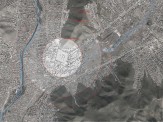
The study site, Dambadarjaa planning unit is located in the northeast part of Ulaanbaatar. It is classified as fringe ger area, where more than half of the residents live in ger rather than detached houses and no formal roads exist. The red dots indicate the location of water kiosks
-

Diagram showing the development of kasha over time
MIN JEONG PARK AR’21
The last two decades of the 21st century in Mongolia witnessed a surge in the influx of labor and capital from the rural areas into the capital city, Ulaanbaatar. After the collapse of the Communist regime in 1992, the adoption of a free-market economy attracted herdsmen from rural areas to the city.
Half of Mongolians live in the capital city and more than half of the residents in Ulaanbaatar live in “ger areas.” That means a staggering 800,000 people live in ger areas, a number which has doubled over the last 25 years. ‘Ger area’ is a unique urban habitation phenomenon caused by the rapid urbanization and migration of herders from the countryside. Driven away of their traditional work by loss of livestock from worsening desertification, the job-seeking nomads move up in the hill regions of Ulaanbaatar, carrying with them gers–traditional Mongolian mobile felt tents. It is this ger that makes the settlements special; the construction and material of gers are those of a temporary structure but Mongolians’ lives in them are not temporary. Ger is more than a type of housing to Mongolians. It is proof of their long traditional nomadic history and culture that is still living. It is more than the affordability and the accessibility of means and materials. It is their identity.
My project for the Menschel Fellowship investigates the distinguishing architectural elements in the ger settlements in Ulaanbaatar, Mongolia. The research looks at the cultural, social, and infrastructural impact of the ger areas in the context of the urban migration of nomads in Mongolia. The intention is to raise awareness of a not-so-well-known part of the world and to spotlight the issues of migration and urbanization that is most pressing for everyone in the world. Lastly, the aim of the research is to inform my focus in my architecture studies: urbanization and settlement in the global migration crisis.
The 16th khoroo (sub-district) in the northeastern part of Ulaanbaatar was chosen as my study site. This Dambadarjaa planning unit is centered around a monastery and park nearby and is categorized as a fringe ger area. There is one decentralized wastewater treatment plant in the center, 20 mainline-connected water supply stations, 7 truck water supply stations, and 12 bathhouses. The most distinguishing feature of the ger areas is the 2-meter-high wooden fences that enclose all the residential plots and their irregular layout. Housing in the ger areas is predominantly single-family and is a mix of traditional gers and owner-built houses, constructed of either brick or wood.
Ger settlements grow over time in multiple stages in a direct relationship to a family’s financial status. A common story goes like this: a family of herdsmen arrives on a truck to one of the many hills of Ulaanbaatar and moves into a ger temporarily that is already set up in a relative’s lot. Sooner or later, they find a job, find a plot to claim, and purchase a ger from a market. A typical home in ger area ger home includes a ger, a self-built attached house, a pit latrine, a coal storage shed, a shed for animals and a few other essentials. But all of this would be meaningless without the fences around the plot. It is a mandatory procedure to legitimize their ownership of the land. This act of enclosure of property by fences, which are called khashaa, is an unprecedented act in Mongolian history. Despite having lived as nomads for generations, they have quickly adapted to this act of privatization. This humble construction of khashaa, which might seem too informal and temporary in our eyes, is widely spread in Ulaanbaatar, where ger settlements continue to sprawl uncontrollably up on the hills surrounding the city center.
The lack of governmental assistance and the explosive growth of ger areas have caused another problem. The ger areas have no basic urban infrastructure–no water, no heating, and no plumbing. Not only can the absence of a supply of clean water and electricity cause much inconvenience and hardship, but the excess consumption of coal in the excruciatingly cold winter makes Ulaanbaatar one of the most air-polluted city in the world. Despite the inferior infrastructure and the absence of public services and public spaces, the settlements remain “dynamic, hybrid spaces in which nomadic/rural and urban lifestyles still merge today, bearing problems but also opportunities for the city, as linkages to former nomadic lifestyles” (Castrillón).
At the outbreak of COVID-19, my plan to travel and do research abroad was turned completely remote, accompanied by necessary changes to my research methodology. Instead of site visits and direct observation, I collected GIS data, satellite images, and maps online. Zoom interviews replaced face-to-face conversations with locals.
These questions remain to be answered:
What does it mean to live in a ger, a temporary structure in a city?
What does it mean to live in a ger area, an informal settlement in a city without basic urban infrastructure?
What does it mean to live in a temporary structure in a city without basic infrastructure and no public space?
Works Cited
Castrillón, Renato D'Alençon, et al. “Social Development and Space Patterns in Ger Settlements: Fencing, Water and Festivities in Yarmag, Ulaanbaatar.” Inner Asia, vol. 18, no. 2, 2016, pp. 223–244.

